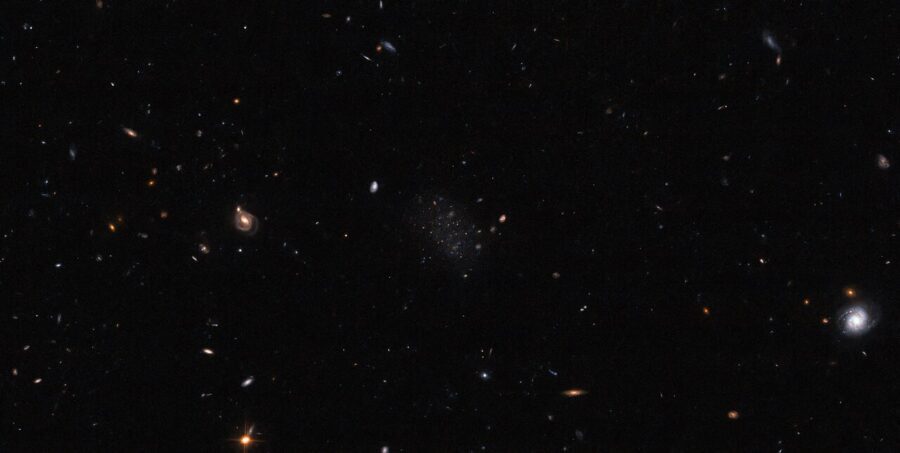22.02.2023
Three dwarf galaxies around the Sculptor Galaxy have come to light thanks to the work of an amateur astronomer.

In the middle of this Hubble Space Telescope image, nestled amongst a smattering of distant stars and even more distant galaxies, lies the newly discovered dwarf galaxy known as Donatiello II.
ESA / Hubble & NASA, B. Mutlu-Pakdil; Acknowledgement: G. Donatiello
Between January and June 2020, as COVID-19 was sweeping the world, an amateur astronomer living in the province of Brindisi in southern Italy made a series of exhilarating discoveries.
Giuseppe Donatiello was poring over images made public by the Dark Energy Survey (DES), which had scanned the southern sky from the Cerro Tololo Inter-American Observatory in Chile. Amid the smattering of stars, gas, and dust, he noticed first one, then two, then three new satellites of the Sculptor Galaxy (NGC 253). Dwarf-size and spheroidal in shape, they had been overlooked by the algorithm set up to spot them.
It isn’t hard to see why. The starlight emitted from them is feeble, faint and shrouded in a haze of interference from objects in the foreground and background. Even the brightest regions are ultra-dim, as is common with dwarf galaxies. Yet they were most assuredly there, and they appeared to be affiliated with NGC 253.
The dwarfs were dubbed Donatiello II, III and IV. A previous quest to photograph the major satellites of Andromeda (M31) had already led Giuseppe to unearth Donatiello I, another far-off dwarf. Including two others in the Local Group, his total count is now six.
A paper detailing the newest discoveries was published in collaboration with David Martinez-Delgado (Institute of Astrophysics of Andalucía, Spain) and others in 2021. David is “unique in the professional scenario” in terms of the working relationships he maintains with amateur astronomers, remarks Giuseppe.
The study draws on the discoveries as well as additional data from the Dark Energy Spectroscopic Instrument (DESI) Legacy Surveys, which combine DES data with that from two other cameras located at Kitt Peak in Arizona. These data aided the analysis by reducing the amount of noise obstructing the signal.
More recently, a different team headed up by Burçin Mutlu-Pakdil (Dartmouth College), also in search of satellites of NGC 253, used the Hubble Space Telescope to obtain images of a number of them. Among them was Donatiello II, which they named Scl-MM-dw3. They thus independently corroborated Giuseppe’s discovery. Hubble, with its more precise measurements, was moreover able to conclusively demonstrate Donatiello II’s association with NGC 253 and rule out the possibility that it was a background projection.
Studying the satellite dwarf galaxies arrayed around NGC 253 helps us build a clearer understanding of how such systems function. The more complete the census, the more accurate our conclusions will be.
The case is emblematic of the way in which dedicated amateurs, in synergy with professionals, continue to push the boundaries of astronomical knowledge. Since the dawn of the internet, institutions have placed large volumes of archived data online, enabling anybody with a computer to comb through and participate in what was previously an exclusive pursuit. Humans are natural image processors and complement the scrutinizing capabilities of automatic detection software.
Giuseppe has been looking skyward since being inspired at a young age, like so many others, by the Apollo missions. Now he has many years of experience under his belt.
Knowing what to look for is key, as imposter artifacts abound. “Before venturing into a search, it is necessary to thoroughly study the morphology [of dwarf galaxies] and their appearance,” notes Giuseppe. “What make the difference between an artifact and a promising source,” he adds, “are cross-checks and mental associations.”
The work is at times arduous and requires “preparation, creativity, and an acceptance that you will spend a lot of time potentially without any results,” says Giuseppe. The rewards, however, are immense.
Quelle: Sky&Telescope

